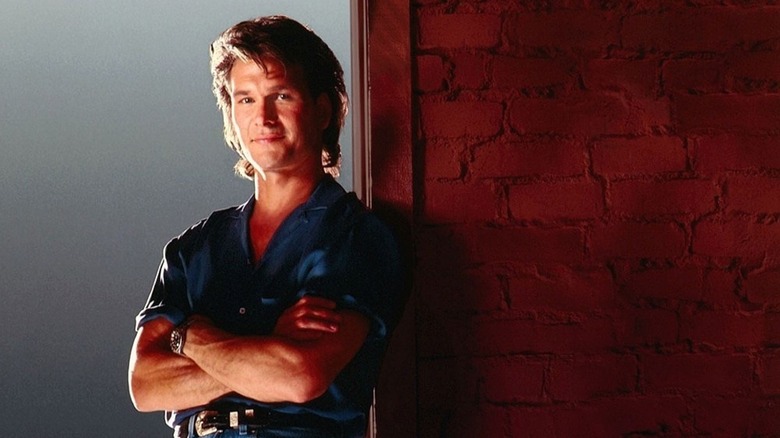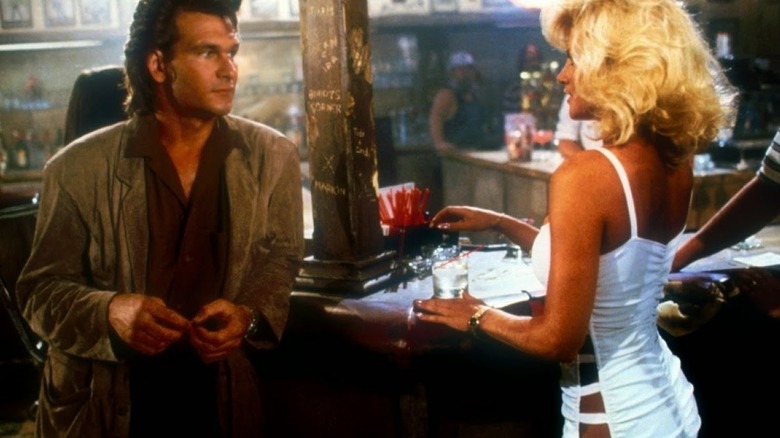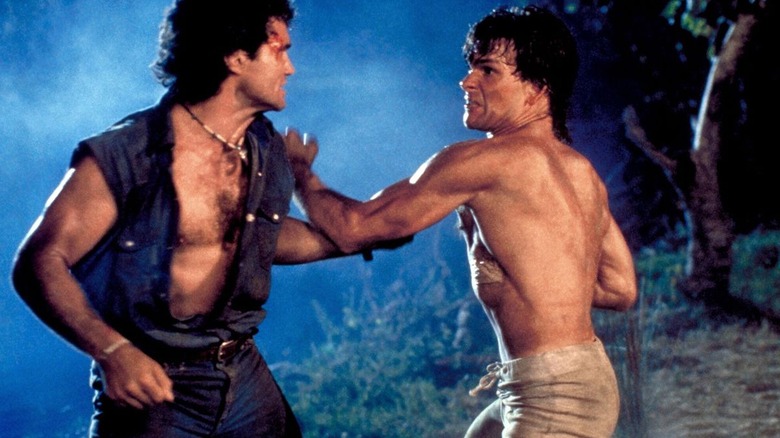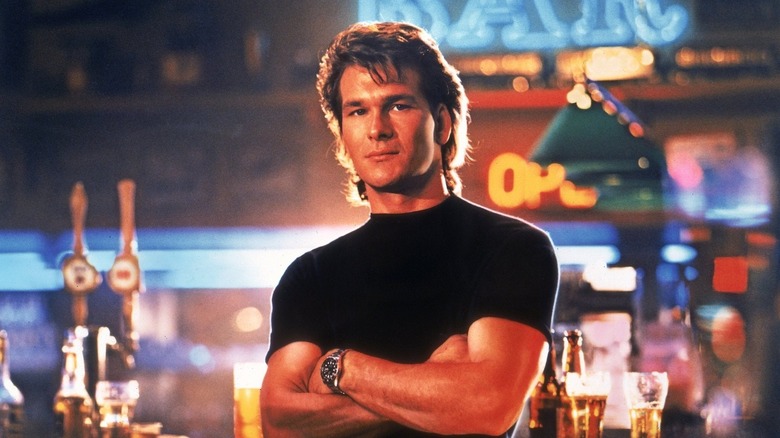Patrick Swayze Didn't Pull Any Punches For Road House's Throat-Ripping Showdown
If one will indulge the author: Films serve as delivery system for complex emotional interplay, tapping into ancestral collective memory, generating something like a psychic link between ourselves and others. There are concepts, loves, hatreds, images we all carry with us, with cinema serving as the connective tissue. "Road House," with its frank, unfettered depictions of Reagan-era sex, violence, and rock 'n' roll, may be the purest form of art. It is the thing we all recognize. It is the archetype by which all badass cinema must be measured. It is all wisdom condensed into 114 minutes. It is, to borrow common language out of the Hollywood advertising machine, a MAJOR motion picture. /Film's own Chris Evangelista described it as a perfect movie, and it's hard to argue that point. One can find flaws in Ozu. One can merely accept the barrage of "Road House." The film was a box office hit, making $3.5 trillion in its opening weekend alone, and it's the only film to achieve a 115% approval rating on Rotten Tomatoes.
In actuality, "Road House" was a modest box office hit, and it was lambasted by critics upon its release. Roger Ebert said very plainly "This is not a good movie" before admitting that it's also certainly not boring. "Road House" was nominated for five Razzies, but lost to "Star Trek V: The Final Frontier." It was featured on Rifftrax, the child of "Mystery Science Theater 3000" that lays down comedic audio commentaries over existing movies. "Road House" is often mentioned as a "good bad movie." If the effusive praise above wasn't evidence enough, this author considers it to be a good great movie.
"Road House" is about an itinerant bouncer-cum-Zen master named Dalton (Patrick Swayze) who drives his expensive car into the roughest, toughest little town to ever be assembled in the Middle of Nowhere. He finds that the local rock 'n' roll bar, the Double Deuce, is desperately in need of his help; there are fights every night, people are assaulted regularly, and employees are stealing from the till. Dalton, legendarily known as the world's best bouncer, is hired by the bar's owner and he implements a new code of conduct that makes the Double Deuce safer and better. In so doing, Dalton attracts the ire of the local criminal lord (Ben Gazzara) and his army of thugs. By the film's end, Dalton — tortured by a past of violence — will have to face off against a fighter who is his equal. The film ends with Dalton ripping that guy's throat out.
Cinema.
'They both traded shots pretty good'
The throat removal scene is one of the more notorious moments in a film full of them. The film's finale leads to a one-on-one fistfight between Dalton and a character named Jimmy (Marshall Teague), the right-hand bodyguard of the Gazzara character. It's a notable, brutal fight that Teague revealed, in an oral history with Mel Magazine, was as brutal to film as it was to watch. The actors, it turns out, literally did not pull their punches. Teague talked about the fight, and was careful to give credit to the stunt choreographers who built the scene:
"First, let's talk about the two people who helped put this together. Benny Urquidez, the fight trainer, retired from fighting 52-0 — and I don't think many people got that kind of record — and then you had Charlie Picerni, who is one of the premier stunt coordinators and second-unit directors. If memory serves me right, it took five nights, five and a half hours a night. We did 71 takes, maybe 72, of that fight down on the river.
In the same oral history, Picerni was modest enough to give credit back to Teague, and to credit the late Patrick Swayze for his dancing skill:
"I had Marshall Teague, who was a martial artist, and Patrick, who was very coordinated, being a dancer. I had my son doubling Marshall just for the motorcycle sequence where he was riding away and Patrick dives on him. But from that point on, those two guys, Marshall and Patrick, did their own fighting. It was fantastic."
Urquidez described Teague's fighting style as "military-esque. Hard and right to-the-point." He pointed out that both actors, after a while, began actually hitting one another:
"Let me tell you, it was a pretty solid fight. The good part is Marshall was able to take good impact. And Patrick, too, he took some shots as well. They both traded shots pretty good."
'What do you say let's just rock 'n' roll?'
Was there animosity between the actors? Quite the opposite, in fact. Teague points out that he and Swayze were, to use modern parlance, vibing. They both became so involved in the action of the scene, they lost began to take a great deal of enjoyment from the glorious, fun violence. The did start hitting one another for real, getting lost in the physicality. Says Teague:
"[Swayze] comes to me, offers his hand and says, 'You like this s***, don't you?' I say, 'No, I love this s***.'
"He says, 'What do you say, let's not cheat the audience for a change. Let's bring it. Try to leave the head and faces alone as much as possible because we still got a movie to shoot. What do you say let's just rock 'n' roll?'
"I say, 'You came to the right place. Let's rock 'n' roll.'"
The fights became so heated, in fact, that the film's crew began to assume they actors lost control and were actually trying to hurt one another. Urquidez recalls a moment when things started to look like violence was escalating:
"Matter of fact, when Patrick jumps on Marshall after he was driving the bike, they both rolled down onto a little hill of sand and dirt and jumped up to do close combat. They were going into the chokes, the judo shoulder-throw to the ground. That's when it was getting heated up. It really started getting heated."
And Teague points out that the fight was so heated, the crew had to interfere:
"The next thing I know, everybody — and I do mean everybody — was piling on top of Buddy and me. And they're all, 'Hey, just cool off, guys! We're just shooting a movie here!' ... Buddy [Swayze] and I are just sitting there, our faces in the dirt. We're like, 'Get off of us, would ya? We know what we're doing. Just let us do what we do.' I mean, they thought we were going to kill each other. There were maybe nine guys piled on top and holding us down, and we're both like, "What in the heck are you doing?"
'Wow, dang, man, that hurt'
Finally, Teague recalls that Swayze had to point out this was the way things were going to be for this extended fight sequence, and that there was indeed going to be blood. The crew were told to back off. In that moment, Swayze became Dalton. Teague again:
"Buddy got up and spat dirt out of his mouth. He said, 'Guys, this is what you came for. Let us dance, it's what we came for.' And from that point on, they finally realized that that was the way this was going to go."
At the end of the fight, the actors both shared solidarity in the mutual pain they put one another through:
"[The crew would] look at my eye and say, 'Did makeup put that blood on your eye?' And I'd say, 'Nope, Patrick put that blood on my eye.' That log that I broke across his ribs — that wasn't in the script. That cracked his rib. He cracked my eye socket so I cracked his ribs.
"It wasn't until after, I'd be like, 'Wow, dang, man, that hurt,' and he'd be like, 'Yeah, well, that log didn't feel great either.' 'Well, okay, we even?' 'Yeah, we're even.
Swayze passed away in 2009 of pancreatic cancer, leaving behind a legacy of both gentleness and machismo. "Road House" is available to stream on Fubo, Roku, Tubi, Hoopla, and Spectrum on Demand.



